Landscape Layer Map

LandscapeLayerMap object represents a Landscape Terrain layer and stores the data used for rendering in an .lmap asset:
- Height map used to generate the geometry of Landscape Terrain.
- Albedo texture representing color data.
- 20 single-channel mask textures.
You can create a new landscape layer map either from scratch, sculpting it with an extendable set of brushes available out-of-the-box, or using imported data (images or tilesets), be it an arbitrary terrain generated in terrain generator software (e.g., World Machine), or real digital elevation maps and satellite imagery data.
You can place layer maps anywhere in the scene by moving, scaling and rotating the node (rotation is available around the Z axis only). By blending different landscape layer maps you can modify the terrain even at run time.
See Also#
- The LandscapeLayerMap class to manage parameters of the Landscape Layer Map via API
- The LandscapeMapFileCreator class to generate .lmap files via API
- The LandscapeMapFileSettings class to load, modify, and apply Landscape Layer Map settings stored in a .lmap file via API
- The Editing Landscape Terrain article to learn about Brush Editor
Creating a Landscape Layer Map#
Create a new landscape layer map via either of the following ways:
-
By creating a node:
-
In the Create menu, select Landscape -> Landscape Layer Map and place the new Landscape Layer Map node in the scene.
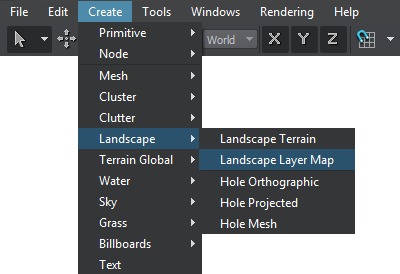
-
By default the map has the blank read-only landscape_layer_map_base.lmap asset set in the Landscape parameter. Click
 to create a new landscape layer asset.
to create a new landscape layer asset.

-
In the Create menu, select Landscape -> Landscape Layer Map and place the new Landscape Layer Map node in the scene.
-
By creating an asset:
-
In the Asset Browser click Create -> Create Landscape Layer Map and specify a name for the new lmap asset.
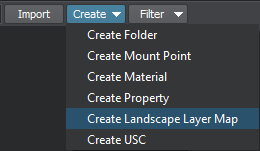
- Then drag the asset to the Scene viewport and place a new Landscape Layer Map in the scene.
-
In the Asset Browser click Create -> Create Landscape Layer Map and specify a name for the new lmap asset.
-
Generating from files:
- Set the Data Filling option to From Tileset.
-
Depending on the desired way to access to the resources, choose the value of the Data Sources parameter:
- Assets. Use available imported textures, which is a pretty good option for small and moderate terrains.
- External Files. Provide full paths to the resources (e.g. a network drive). A better option for large terrains with extremely dense graphic data.
- Specify the resources: albedo and height textures (or texture tilesets) and up to 20 mask textures. In the case of using tilesets, specify only first tiles and appropriate naming patterns.
- Adjust other import settings. For instance, you can redefine the Resolution of the Landscape Layer Map textures.
- Click Reimport to load the provided resources.
- Modify the layer using Brush Editor.
-
Sculpting from scratch:
- Set the Data Filling option to Manual.
- Choose the Resolution of the LandscapeLayerMap textures and click Reimport to apply changes.
- Click Brush Edit and open Brush Editor to draw over the layer map surface and thus sculpt the layer from scratch.
Watch a quick video guide below on creating and editing a Landscape Terrain and Layer Maps:
Landscape Layer Map Parameters#
Landscape Asset Parameters#

| Size | Width and Length, in units. Click Edit Size to toggle the size editing mode. |
|---|---|
| Current Data Density | Layer map density (the size divided by the resolution), in meters/pixel |
| Landscape | .lmap asset to store the landscape data. By default it is the blank read-only landscape_layer_map_base.lmap asset, to edit the layer map you can create a new asset by using the  Create button or specify an existing one. Brush Edit opens Brush Editor. Create button or specify an existing one. Brush Edit opens Brush Editor.
Notice Several Landscape Layer Maps can refer to the same .lmap asset without extra memory required. |
| Height Scale | Scale multiplier along the Z axis. |
| Order | The layer rendering order used in layers blending (higher numbers on top) |
| Collision | Collision with the map |
| Intersection | Intersection with the map |
| Culling | Streaming is based on using previously loaded geometry to define what is going to be streamed next. This option enables uploading preliminary low-level data of all maps to CPU to be used for initializing the streaming. If disabled, only low-level data of the base map is uploaded on CPU. |
Import Settings#
Import Setting are the settings of the Landscape asset associated with the Landscape Layer Map node.
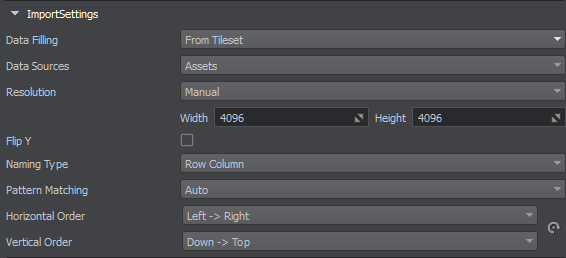
There is a set of buttons to work with import settings:

| Restore Defaults | Reset all settings to the default values. |
|---|---|
| Reimport | Reload all graphic resources with respect to the specified import parameters. Click Reimport after making any changes to the import settings to apply them. |
| Cancel | Discard changes made to the import parameters. |
Import settings:
| Data Filling | Origin of terrain data:
|
|---|---|
| Data Sources | Where data is taken from:
Notice
The engine doesn't track the changes made to external files. If there are some changes, you can update graphic data via the textures_reload console command. |
| Resolution | Resolution of maps limited only by available memory.
|
| Flip Y | Flip tiles along the Y axis |
| Naming Type | The source tileset layout type. The following values are available:
|
| Pattern Matching |
|
| Pattern | A string naming pattern (e.g. _%X_%Y for the Row Column naming type or _%X for the Indexed type). |
| Number of Columns | The number of tiles in the tileset. |
| Horizontal Order | Horizontal loading direction of the source tileset.
|
| Vertical Order | Vertical loading direction of the source tileset.
|
Import Maps#
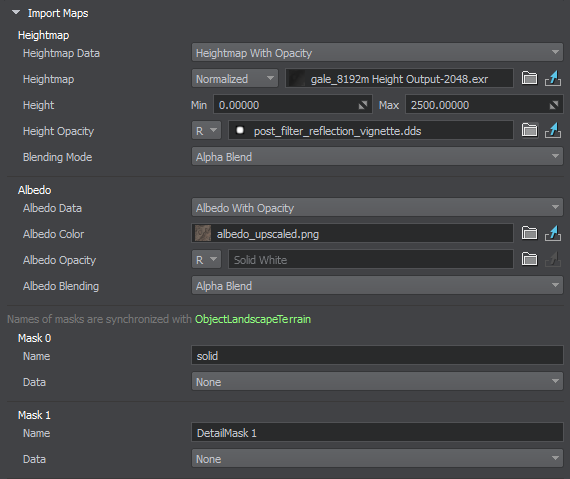
| Heightmap | |
|---|---|
| Heightmap data |
|
| Heightmap | Normalized/Unnormalized |
| Height | Min/Max — the values used to transform the value [0,1] stored in the heightmap to meters. |
| Height opacity | Sets the height opacity map and channel where data is stored. |
| Blending mode |
|
| Albedo | |
| Albedo Data |
|
| Albedo Color | Albedo color image |
| Albedo opacity | Sets the albedo opacity map and channel where data is stored. |
| Albedo Blending |
|
| Mask | |
| Name | The mask name, which is synchronized with the current active ObjectLandscapeTerrain. |
| Data |
|
| Color | The channel of the image to be applied as mask to the LandscapeLayerMap. |
| Opacity | Sets the opacity map and channel where data is stored. |
| Blending | Mode of blending this detail layer with other data layers:
|
Maps#
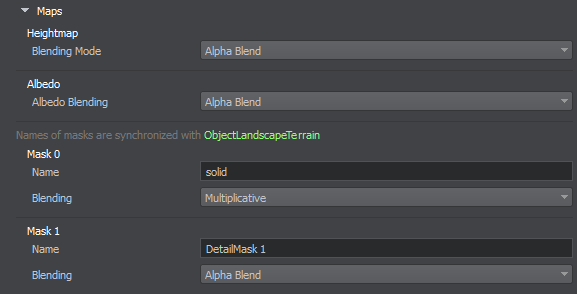
| Heightmap | |
|---|---|
| Blending mode |
|
| Albedo | |
| Albedo Blending |
|
| Mask | |
| Name | The mask name, which is synchronized with the current active ObjectLandscapeTerrain. |
| Blending | Mode of blending this detail layer with other data layers:
|